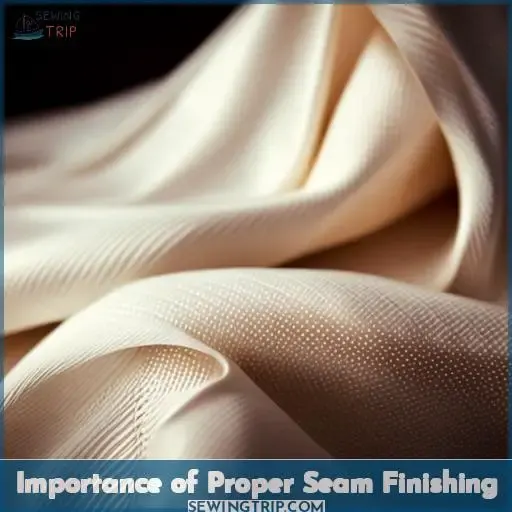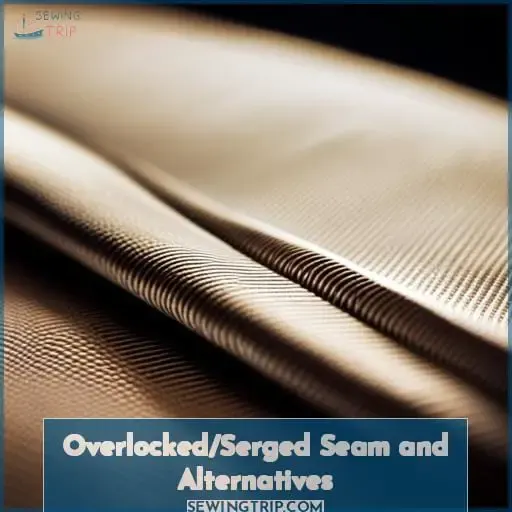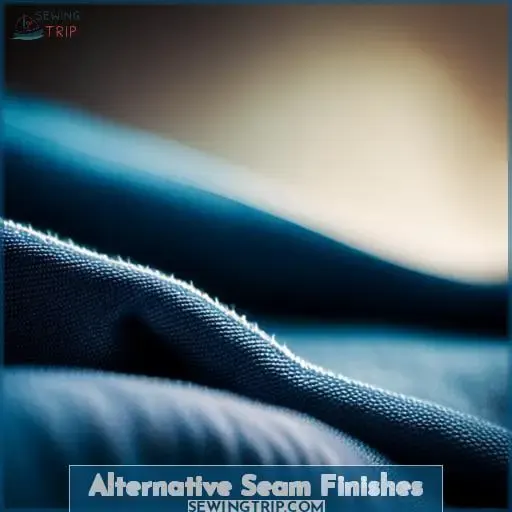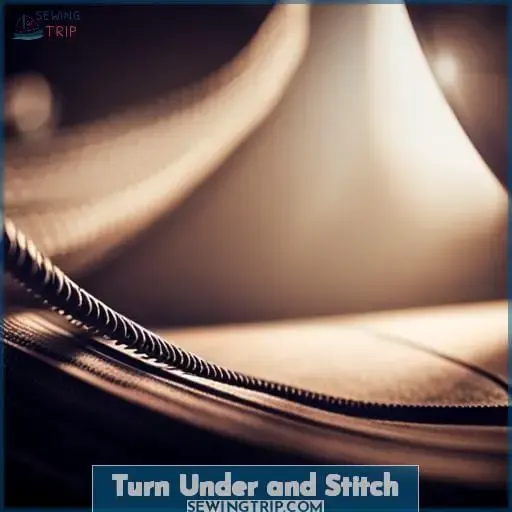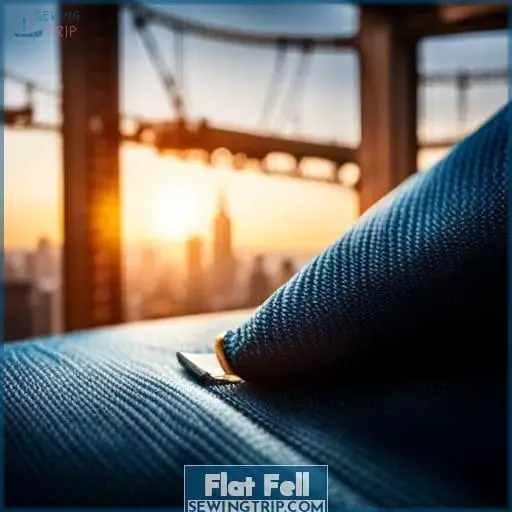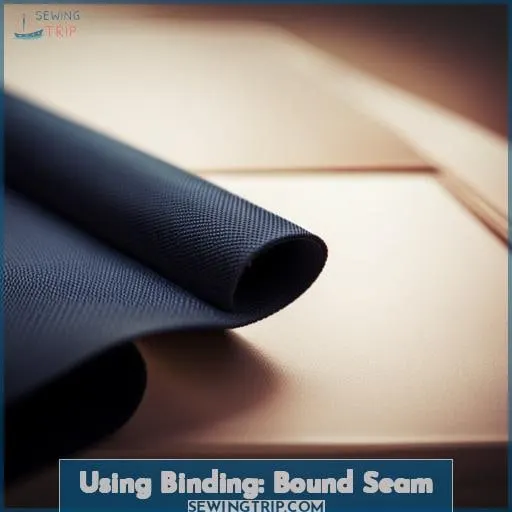This site is supported by our readers. We may earn a commission, at no cost to you, if you purchase through links.
 Imagine the satisfaction you’ll feel when your sewing projects look professional and withstand the test of time.
Imagine the satisfaction you’ll feel when your sewing projects look professional and withstand the test of time.
By properly finishing your seams, you’ll prevent fraying and ensure clean, durable stitches that won’t unravel over time.
So grab your fabric and let’s dive into the importance of proper seam finishing to unlock a world of sewing possibilities!
Table Of Contents
Key Takeaways
- Raw edges are exposed, unfinished fabric ends that can fray if not secured.
- Various seam finishing techniques are available, such as zigzag stitching, overlocking, pinking shears, and bias binding.
- The choice of technique depends on factors such as fabric type and project requirements.
- Understanding raw edges allows for creative seam choices, including decorative stitches and mixed media treatments.
Understanding Raw Edges
To properly secure raw edges, it’s essential to understand the nature of these fabric edges that become unraveled when cut.
Raw edges are the exposed, unfinished ends of fabric that can fray and unravel if left unsecured. They require proper seam finishing techniques to prevent this from happening and ensure a clean and durable finish for your sewing projects.
When it comes to securing raw edges, there are various options depending on your preferred method and available equipment.
Sewing machines offer versatility with options like zigzag stitching or using special feet for different edge finishes. On the other hand, overlockers provide quick and convenient solutions with multiple stitch variations specifically designed for securing raw edges.
Understanding which technique to use depends on factors such as fabric type (lightweight or heavy), project requirements (decorative vs functional), personal preference (professional vs creative finish), etc.
By exploring different seam finishing techniques like pinking shears, bias binding, overcast stitch, flat felled seams in combination with suitable sewing machine or overlocker settings , you can achieve both practicality and creativity in securing those pesky raw edgesto suit your specific needs.
With a deeper understanding of how fabrics behave at their cut ends called ‘raw edgess’, you gain control over their potential fraying tendencies while also unlocking new possibilities for innovative edge finishes.
Creative approaches include decorative stitches,mixed media treatments,and even incorporating contrasting colors.
This knowledge empowers you as a sewist,paving way towards mastery by ensuring professional-looking results every time,your garments will stand out not only through impeccable construction but also through unique design details made possible by creative seaming choices
Importance of Proper Seam Finishing
Now let’s talk about why proper seam finishing is so important.
Clean seams are a hallmark of well-made sewing projects and can instantly elevate the overall appearance of your garment or item. On the other hand, frayed or raveling seams give off a homemade look that may not be desirable.
Additionally, properly finished seams help prevent irritation against the skin and minimize thread buildup during washing, ensuring longevity for your creations.
Clean Seams
Now let’s dive into the importance of achieving clean seams when it comes to properly finishing your sewing projects.
Clean finishes not only enhance the overall appearance of your garment but also contribute to seam quality and durability. By employing proper stitching techniques and considering fabric types, you can ensure that your seams are strong, neat, and long-lasting.
Whether you opt for serging or overcast seams, prioritizing clean finishes will elevate the professionalism of your sewing endeavors.
Homemade Vs. Professional
When it comes to the importance of proper seam finishing, distinguishing between homemade and professional sewing is crucial.
The stitching techniques used in homemade projects may not always result in the same level of seam durability as those done by professionals. Additionally, fabric selection plays a significant role in determining the effectiveness of edge finishes and seam allowances.
Investing in quality sewing equipment can help achieve more polished results and ensure that your finished garments have a professional touch.
Preventing Irritation
Prevent irritation by ensuring proper seam finishing.
- Choose the right stitching techniques for your fabric edges.
- Consider different seam types that prevent fraying and provide a clean finish.
- Use suitable sewing equipment for securing raw edges effectively.
Overlocked/Serged Seam and Alternatives
Now let’s talk about overlocked/serged seams and alternatives.
This method is quick, convenient, and suitable for all types of fabrics. If you have a serger machine, it makes finishing seams a breeze. But don’t worry if you don’t have one – there are alternative methods that can achieve similar results without a serger.
Quick and Convenient Method
Secure your raw edges quickly and conveniently by using overlocked/serged seams or alternative methods.
A serged seam creates a neat, professional finish that prevents fraying and adds durability to lightweight fabrics. If you don’t have access to a serger, you can achieve similar results with a zigzag stitch on your sewing machine.
This versatile technique allows for decorative edges while ensuring the raw edge is securely finished.
Explore these quick finishing options for seamless sewing techniques!
| Serger Benefits | Seam Alternatives |
|---|---|
| Neat finish | Zigzag stitch |
| Prevents fraying | Decorative edges |
Suitable for All Fabrics
You can rely on overlocked/serged seams and alternative methods to secure raw edges, as they’re suitable for all types of fabrics. These techniques provide reliable edge finishing options for your sewing projects.
Whether you’re working with delicate silk or sturdy denim, overlocked seams ensure durability while maintaining a professional appearance. With various seam options available, you have the flexibility to choose the most suitable technique for each fabric type and achieve impeccable results in your sewing endeavors.
Alternative Methods Without a Serger
To achieve a finished seam without the use of a serger, explore alternative methods suitable for all fabric types.
- Zigzag stitching is one option that provides secure edges and prevents fraying.
- Pinking shears create decorative zigzag patterns while also preventing unraveling.
- Other creative finishes include using rotary cutters with wavy blades or overcast seams that mimic serged edges.
These alternative methods offer versatility in seam finish techniques and provide various fabric edge options to choose from.
Alternative Seam Finishes
Let’s explore some alternative seam finishes that can add both functionality and style to your sewing projects.
- Pinking shears are a great tool for preventing fraying while also adding decorative edges.
- Rotary cutters with wavy blades offer another option for preventing raveling and creating unique, textured finishes.
- Zigzagging is suitable for stable fabrics like cotton poplin or linen, providing a secure edge finish.
- Lastly, overcast seams mimic serged seams and can be used on most types of fabrics, giving you a professional look without the need for specialized equipment.
Pinking Shears
By using pinking shears, you can create an alternative seam finish that prevents fraying and adds a decorative edge to your fabric.
-
Pinking Shears Benefits:
- Prevents fraying
- Adds decorative edge
-
Creative Edge Finishes:
- Zigzag patterns
- Scalloped edges
-
Decorative Zigzagging Ideas:
- Curved lines
- Geometric designs
-
Choosing Seam Finish:
- Consider fabric type and desired look.
Rotary Cutters With Wavy Blades
Continuing the exploration of alternative seam finishes, consider using rotary cutters with wavy blades for a unique and decorative edge. These specialized tools allow you to achieve both edge protection and an eye-catching finish.
By incorporating zigzagged seams into your sewing projects, you can add flair to garments or create stunning accents on home decor items.
Zigzagging
Now let’s dive into an alternative seam finishing technique called zigzagging, which provides a secure and decorative edge to your sewing projects. Zigzagging techniques offer various options for seam finishes, allowing you to choose the most suitable one for your raw edges.
This method utilizes sewing machine stitches like the zig zag stitch, offering solutions for pinked seams or curved seams.
Overcast Seams
To achieve a secure and professional finish, effectively secure raw edges with an alternative seam finish.
Overcast seams offer a great solution for preventing fraying and adding durability to your projects.
By using various sewing machine stitches and techniques, you can create different seam edge variations that will give your garments or items a polished look.
Try experimenting with binding or bound seams for even more options!
French Seam
As we delve further into seam finishing techniques, let’s explore the elegant and enclosed French Seam.
The French seam is a go-to method for sewing chiffon and other delicate fabrics, providing a clean and polished finish.
To create this sophisticated stitch, start by sewing with a ¼ inch seam allowance while keeping the back side of the fabric facing you.
Next, trim any excess fabric from the raw edge before folding it inwards twice; first at ¼ inch then again at another ¼ inch to enclose those pesky raw edges completely within the fold.
Finally, sew along that folded hemline to secure everything in place beautifully.
French Seam Tips:
- Use fine pins when working with thin or sheer fabrics to avoid snagging or leaving visible marks.
- Pressing as you go is crucial for achieving crisp folds and seamless results.
- Take your time when trimming excess fabric from seams; precision ensures an impeccable finish.
- Practice on scrap pieces before attempting your French seams on actual garments.
Mastering this technique will allow you to create professional-looking finishes for silk garments or any project requiring delicate fabric handling.
Turn Under and Stitch
When working with light and medium-weight fabrics, the turn under and stitch method is a great option for finishing raw edges.
After stitching your seam, press it open to create a clean look.
Then, carefully press under the raw edge of one side of the seam allowance using a pressing cloth to avoid marking through to the right side of your garment.
Finally, secure this fold in place by edge stitching it down and repeat on the other side for a professional finish that prevents fraying.
Suitable for Light and Medium-Weight Fabrics
First, determine if your fabric is light or medium-weight.
For these types of fabrics, the turn under and stitch method is a suitable edge finish option.
After stitching the seam and pressing it open, press under the raw edge of one side of the seam allowance.
Use a pressing cloth to prevent marking through to the garment’s right side.
Finally, edge stitch the fold to secure it in place and repeat for the other side.
This technique provides a clean and professional look for your garments made with light or medium-weight fabrics.
Stitching and Pressing Open
Now let’s move on to stitching and pressing open the seam allowance, an essential step in properly finishing raw edges. By using stitching techniques and careful seam pressing, you can achieve clean and professional-looking seams.
Stitch the seam together first, then press under the raw edge of one side of the seam allowance using a pressing cloth to avoid marking through onto your garment’s right side.
Pressing Under the Raw Edge
Press under the raw edge of one side of the seam allowance, securing it in place with an edge stitch.
This pressing technique is crucial for proper seam finishing and ensures that your garment has durability and a clean appearance. By turning under the raw edge and stitching it down, you prevent fraying and create a polished look.
Take care to use a pressing cloth to avoid marking through to the garment’s right side as you press.
Serging or Zig Zag (on a Home Sewing Machine)
To secure raw edges on your sewing projects, start by using a serging or zig zag stitch on a home sewing machine. These techniques are essential for seam finishing and ensuring the longevity of your creations.
- Serging Tips:
- Utilize a serger machine if available, as it’s specifically designed for this type of stitching.
- Adjust the settings according to the fabric thickness and desired finish.
- Zigzag Stitching:
- If you don’t have access to a serger, use the zigzag stitch function on your home sewing machine instead.
- Set the stitch width and length appropriately for optimal edge coverage.
- Seam Finishing:
- Whether using serge or zigzag stitches, run them along the raw fabric edge to prevent fraying and unraveling over time.
- Raw Edge Solutions:
- Iron any excess seam allowance towards the back of your garment after completing either technique mentioned above. This step will give your finished piece that clean appearance we all strive for.
- Home Sewing Techniques:
- Remember that both serging and zigzag stitching can be used with various types of fabrics during different stages of construction.
By incorporating these simple yet effective methods into your sewing routine, you’ll achieve impeccable seam finishes while gaining confidence in mastering these fundamental home sewing techniques!
Flat Fell
To achieve a professional and durable finish, try the flat fell method for securing raw edges in your sewing projects. Flat felling is a technique commonly used in denim finishing and works exceptionally well with heavy fabrics.
It not only provides strength but also gives your garment a polished, high-quality look.
The benefits of using the flat fell seam are numerous. Firstly, it creates a clean and professional appearance both on the inside and outside of your project. The raw edge is neatly enclosed within the folds of fabric, ensuring no fraying or unraveling over time.
In terms of sewing techniques, creating a flat fell seam requires precision stitching at specific measurements to ensure proper folding and overlapping of fabric layers. By following this technique accurately, you can achieve strong seams that withstand tension without compromising on aesthetics.
When working with heavy fabrics like denim or canvas where durability is paramount, implementing the flat fell method becomes even more crucial. The extra layer created by folding over one side of the seam allowance adds an additional level of reinforcement to prevent any structural weaknesses from forming.
So if you’re looking to elevate your sewing skills while ensuring longevity in your handmade pieces made from heavyweight materials such as denim or canvas—give yourself liberation by embracing mastery over this powerful tool known as ‘flat felling.
Using Binding: Bound Seam
To create a professional and finished look for your seams, try using binding to create a bound seam.
Binding techniques are an excellent option for seam finishing that adds durability and style to your garments. When you use binding on the garment edge, it not only secures the raw edges but also creates a neat and polished appearance.
There are different stitch options available when using binding for bound seams. You can choose between straight stitches or decorative stitches depending on the desired look of your project. Sewing tips suggest aligning the pre-cut or homemade fabric strip with the raw edge of your fabric, stitching at ¼ inch from the edge, and then folding over to close it with another straight stitch along its top.
Using this technique can be particularly beneficial when working with heavy fabrics or outerwear pieces where extra reinforcement is needed. It ensures that even under stress or movement, such as in coats or jackets sleeves’ hems will remain intact.
So whether you’re sewing clothes for yourself or others, incorporating binding into your seam finishing repertoire will elevate both functionality and aesthetics in every piece you make!
Frequently Asked Questions (FAQs)
What are some common mistakes to avoid when securing raw edges?
When securing raw edges, avoid these common mistakes:
- Skipping the finishing step.
- Using the wrong technique for your fabric type.
- Neglecting to test stitches on scraps first.
Empower yourself with proper edge finishes!
Can you provide tips for choosing the right sewing machine foot or stitch for securing raw edges?
To choose the right sewing machine foot or stitch for securing raw edges, consider your fabric type and desired finish.
Experiment with different options to find what works best for you. It’s all about finding that perfect match!
Are there any specific fabrics that require special techniques for securing raw edges?
When it comes to securing raw edges, certain fabrics require special techniques.
Delicate materials like silk and chiffon benefit from French seams for a polished look.
Heavier fabrics such as denim call for the durability of flat felled seams.
Mastering these techniques empowers you to create flawless garments.
How can I prevent fraying and unraveling when working with delicate fabrics?
To prevent delicate fabrics from fraying and unraveling, you must hold them hostage!
Secure those raw edges with gentle precision.
Bind them tightly in the arms of your stitches.
Don’t let go until they’re locked into place, forever under your control.
Are there any alternative methods for securing raw edges if I don’t have access to certain equipment or machines?
If you don’t have access to certain machines or equipment, no worries! There are alternative methods for securing raw edges.
Try using:
- Pinking shears
- Rotary cutters with wavy blades
- Zigzag stitches
- Overcast seams
for a clean and polished finish.
Conclusion
Incorporating proper seam finishing techniques is essential in achieving professional-looking sewing projects that will stand the test of time.
Understanding raw edges and the importance of finishing seams can prevent fraying, ensure clean stitches, and avoid unraveling over time.
From overlocked/serged seams to alternative finishes like pinking shears, zigzagging, and French seams, there are various methods to choose from based on fabric type and personal preference.
So, embrace the world of sewing possibilities and elevate your skills with proper seam finishing techniques.


